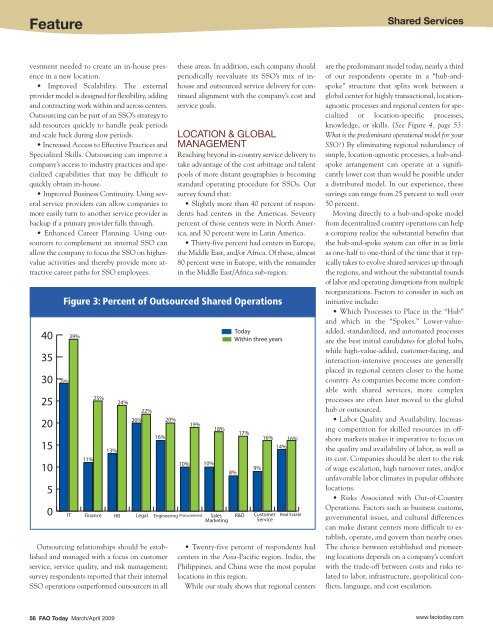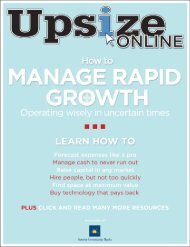March/April 2009 www.FAOToday.com
March/April 2009 www.FAOToday.com
March/April 2009 www.FAOToday.com
Create successful ePaper yourself
Turn your PDF publications into a flip-book with our unique Google optimized e-Paper software.
Feature<br />
Shared Services<br />
vestment needed to create an in-house presence<br />
in a new location.<br />
• Improved Scalability. The external<br />
provider model is designed for flexibility, adding<br />
and contracting work within and across centers.<br />
Outsourcing can be part of an SSO’s strategy to<br />
add resources quickly to handle peak periods<br />
and scale back during slow periods.<br />
• Increased Access to Effective Practices and<br />
Specialized Skills. Outsourcing can improve a<br />
<strong>com</strong>pany’s access to industry practices and specialized<br />
capabilities that may be difficult to<br />
quickly obtain in-house.<br />
• Improved Business Continuity. Using several<br />
service providers can allow <strong>com</strong>panies to<br />
more easily turn to another service provider as<br />
backup if a primary provider falls through.<br />
• Enhanced Career Planning. Using outsourcers<br />
to <strong>com</strong>plement an internal SSO can<br />
allow the <strong>com</strong>pany to focus the SSO on highervalue<br />
activities and thereby provide more attractive<br />
career paths for SSO employees.<br />
40<br />
35<br />
30<br />
25<br />
20<br />
15<br />
10<br />
5<br />
0<br />
Outsourcing relationships should be established<br />
and managed with a focus on customer<br />
service, service quality, and risk management;<br />
survey respondents reported that their internal<br />
SSO operations outperformed outsourcers in all<br />
these areas. In addition, each <strong>com</strong>pany should<br />
periodically reevaluate its SSO’s mix of inhouse<br />
and outsourced service delivery for continued<br />
alignment with the <strong>com</strong>pany’s cost and<br />
service goals.<br />
LOCATION & GLOBAL<br />
MANAGEMENT<br />
Reaching beyond in-country service delivery to<br />
take advantage of the cost arbitrage and talent<br />
pools of more distant geographies is be<strong>com</strong>ing<br />
standard operating procedure for SSOs. Our<br />
survey found that:<br />
• Slightly more than 40 percent of respondents<br />
had centers in the Americas. Seventy<br />
percent of those centers were in North America,<br />
and 30 percent were in Latin America.<br />
• Thirty-five percent had centers in Europe,<br />
the Middle East, and/or Africa. Of these, almost<br />
80 percent were in Europe, with the remainder<br />
in the Middle East/Africa sub-region.<br />
Figure 3: Percent of Outsourced Shared Operations<br />
29%<br />
39%<br />
11%<br />
25%<br />
13%<br />
24%<br />
20%<br />
22%<br />
16%<br />
20%<br />
IT Finance HR Legal Engineering Procurement Sales R&D Customer Real Estate<br />
Marketing<br />
Service<br />
19%<br />
10% 10%<br />
18%<br />
Today<br />
Within three years<br />
8%<br />
17%<br />
9%<br />
16%<br />
16%<br />
14%<br />
• Twenty-five percent of respondents had<br />
centers in the Asia-Pacific region. India, the<br />
Philippines, and China were the most popular<br />
locations in this region.<br />
While our study shows that regional centers<br />
are the predominant model today, nearly a third<br />
of our respondents operate in a “hub-andspoke”<br />
structure that splits work between a<br />
global center for highly transactional, locationagnostic<br />
processes and regional centers for specialized<br />
or location-specific processes,<br />
knowledge, or skills. (See Figure 4, page 53:<br />
What is the predominant operational model for your<br />
SSO?) By eliminating regional redundancy of<br />
simple, location-agnostic processes, a hub-andspoke<br />
arrangement can operate at a significantly<br />
lower cost than would be possible under<br />
a distributed model. In our experience, these<br />
savings can range from 25 percent to well over<br />
50 percent.<br />
Moving directly to a hub-and-spoke model<br />
from decentralized country operations can help<br />
a <strong>com</strong>pany realize the substantial benefits that<br />
the hub-and-spoke system can offer in as little<br />
as one-half to one-third of the time that it typically<br />
takes to evolve shared services up through<br />
the regions, and without the substantial rounds<br />
of labor and operating disruptions from multiple<br />
reorganizations. Factors to consider in such an<br />
initiative include:<br />
• Which Processes to Place in the “Hub”<br />
and which in the “Spokes.” Lower-valueadded,<br />
standardized, and automated processes<br />
are the best initial candidates for global hubs,<br />
while high-value-added, customer-facing, and<br />
interaction-intensive processes are generally<br />
placed in regional centers closer to the home<br />
country. As <strong>com</strong>panies be<strong>com</strong>e more <strong>com</strong>fortable<br />
with shared services, more <strong>com</strong>plex<br />
processes are often later moved to the global<br />
hub or outsourced.<br />
• Labor Quality and Availability. Increasing<br />
<strong>com</strong>petition for skilled resources in offshore<br />
markets makes it imperative to focus on<br />
the quality and availability of labor, as well as<br />
its cost. Companies should be alert to the risk<br />
of wage escalation, high turnover rates, and/or<br />
unfavorable labor climates in popular offshore<br />
locations.<br />
• Risks Associated with Out-of-Country<br />
Operations. Factors such as business customs,<br />
governmental issues, and cultural differences<br />
can make distant centers more difficult to establish,<br />
operate, and govern than nearby ones.<br />
The choice between established and pioneering<br />
locations depends on a <strong>com</strong>pany’s <strong>com</strong>fort<br />
with the trade-off between costs and risks related<br />
to labor, infrastructure, geopolitical conflicts,<br />
language, and cost escalation.<br />
56 FAO Today <strong>March</strong>/<strong>April</strong> <strong>2009</strong><br />
<strong>www</strong>.faotoday.<strong>com</strong>
















